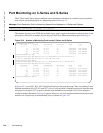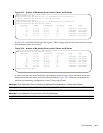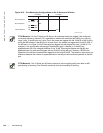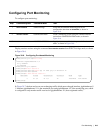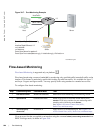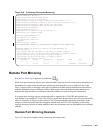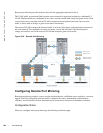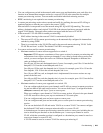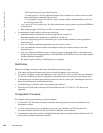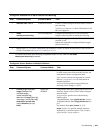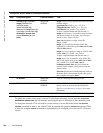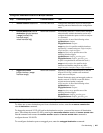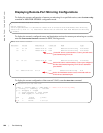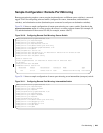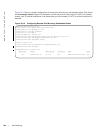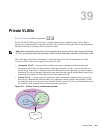824 | Port Monitoring
www.dell.com | support.dell.com
- The VLAN consists of more than 128 ports.
- You add a port to a VLAN, which has already been configured in a source session, and the
newly added port exceeds the 128-port limit.
- You configure a range of VLANs in a source session and the combined number of ports in
the VLANs exceeds 128.
• You can use ACLs on a source port. In a flow-based source session, packets sent from the RPM are
not monitored.
• Rate-limiting tagged-VLAN egress traffic on a source port is supported.
• In a destination session used for remote port mirroring:
• Maximum number of destination sessions supported on a switch: 64
Maximum number ports supported in a destination session: 64
• You can configure any port as a destination port. A port-channel interface is not supported as a
destination port.
• You can configure additional destination ports in an active session.
• You can tunnel the mirrored traffic from multiple remote-port source sessions to the same
destination port.
• You can configure a destination port to send only tagged or untagged traffic to the analyzer. By
default, the port sends untagged packets so that the reserved VLAN ID is removed and the original
monitored packet is analyzed.
• By default, ingress traffic on a destination port is dropped.
Restrictions
When you configure remote port mirroring, the following restrictions apply:
• You cannot configure the same source port to be used in multiple source sessions.
• You cannot configure a source port channel or source VLAN in a source session if the port channel or
VLAN has a member port that is configured as a destination port in a remote-port mirroring session.
• A destination port for remote port mirroring cannot be used as a source port, including the session in
which the port functions as the destination port.
• A destination port cannot be used in any spanning tree instance.
• The reserved VLAN used to transport mirrored traffic must be a L2 VLAN. L3 VLANs are not
supported.
Configuration Procedure
To configure remote port mirroring, you must configure:
1. A reserved L2 VLAN used to transport (switched) mirrored packets on source, intermediate, and
destination switches
2. A source session that consists of multiple source ports, port channels, and VLANs which are
associated with the dedicated VLAN and located on different source switches
3. A destination session that consists of multiple destination ports associated with the dedicated VLAN
and located on different destination switches



